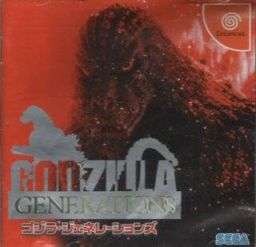Godzilla Generations
| Godzilla Generations | |
|---|---|
|
Japanese Dreamcast cover art | |
| Developer(s) | General Entertainment |
| Publisher(s) | Sega |
| Series | Godzilla |
| Platform(s) | Dreamcast |
| Release date(s) | |
| Genre(s) | Action |
| Mode(s) | Single-player |
Godzilla Generations (ゴジラ ジェネレーションズ Gojira Jenerēshonzu) is an action video game for the Sega Dreamcast, developed by General Entertainment and published by Sega. It was released on November 27, 1998 as one of the four launch titles available for the Dreamcast in Japan,[2] and would remain exclusive to that territory. The game, based on the popular Godzilla franchise, has players assuming the role of various giant monsters in an attempt to destroy real-life Japanese cities.
A sequel titled Godzilla Generations: Maximum Impact was released in Japan the following year.
Gameplay
Players control one of five monsters from the Godzilla universe, initially only Godzilla and Mechagodzilla can be selected, the other characters are unlocked by progressing through the game. The game world is composed of five cities, each comprising two stages, except the final city which has three. The object of the game is to proceed to the next stage by destroying everything on the stage within a set time limit, such as buildings and trees. Each character has projectile attacks, the ability to block incoming attacks and the ability to heal themselves.[2]
Monsters
Reception
| Reception | ||||||||||
|---|---|---|---|---|---|---|---|---|---|---|
| ||||||||||
Godzilla Generations received lukewarm reviews from Japanese gaming magazine Famitsu and a very negative response from Western journalists, despite fans showing interest in the game at the 1998 Tokyo Game Show.[4] Computer and Video Games' reviewer Kim Randell described the game as dull and cited issues such as poor controls, a constantly shifting camera and the player character blocking the player's view.[3] Peter Bartholow of GameSpot derided the game as "terrible"[2] and one of the worst games of 1998.[2] Bartholow found it impossible to block incoming attacks due to the creatures' slow gait. He stated that because of this the developers added a healing ability to each creature, allowing players to continue through the game without fear of their character dying, "There's no strategy, no technique. Just the extreme tedium of tromping through cities."[2]
Despite showing interest in a preview, describing the game as looking like "a riot",[5] Jaz Rignall of IGN and his colleagues were less enthusiastic when their first Dreamcast console arrived three months later with three Japanese launch games. He found "while it brought many smiles and jeers, it didn't impress",[6] the gathered journalists quickly lost interest and moved onto another game.[6] In a November 2002 review of Godzilla: Destroy All Monsters Melee, GameSpy's David Hodgson described himself as "still wincing from Godzilla: Generations".[7] He went on to say the game "seemed to adhere to the loony premise that bizarre camera angles, a monster trudging in extreme slow motion, and the knuckle-gnawingly slow chipping away of scenery was the new high watermark in monstrous fighting action. It wasn't. It was crap".[7]
Japan-GameCharts reports that the game sold approximately 22,870 copies.[8]
References
- ↑ "Godzilla Generations overview". allgame. Retrieved 2008-12-04.
- 1 2 3 4 5 6 Bartholow, Peter (1998-12-18). "Godzilla Generations Review". GameSpot. Retrieved 2008-12-04.
- 1 2 Randell, Kim (2001-08-15). "Review: Godzilla Generations". Computer and Video Games. Retrieved 2008-12-04.
- ↑ "TGS: Gamers Show Renewed Faith in Sega". IGN. 1998-10-15. Retrieved 2008-12-04.
- ↑ Rignall, Jaz (1998-09-01). "Godzilla Generations Preview". IGN. Retrieved 2008-12-04.
- 1 2 Rignall, Jaz (1998-12-01). "Dreamcast Arrives at IGN". IGN. Retrieved 2008-12-04.
- 1 2 Hodgson, David (2002-11-09). "Godzilla: Destroy All Monsters Melee Review". GameSpy. Retrieved 2008-12-04.
- ↑ "Sega Dreamcast Japanese Ranking". Japan-GameCharts.com. Retrieved 2008-12-27.
